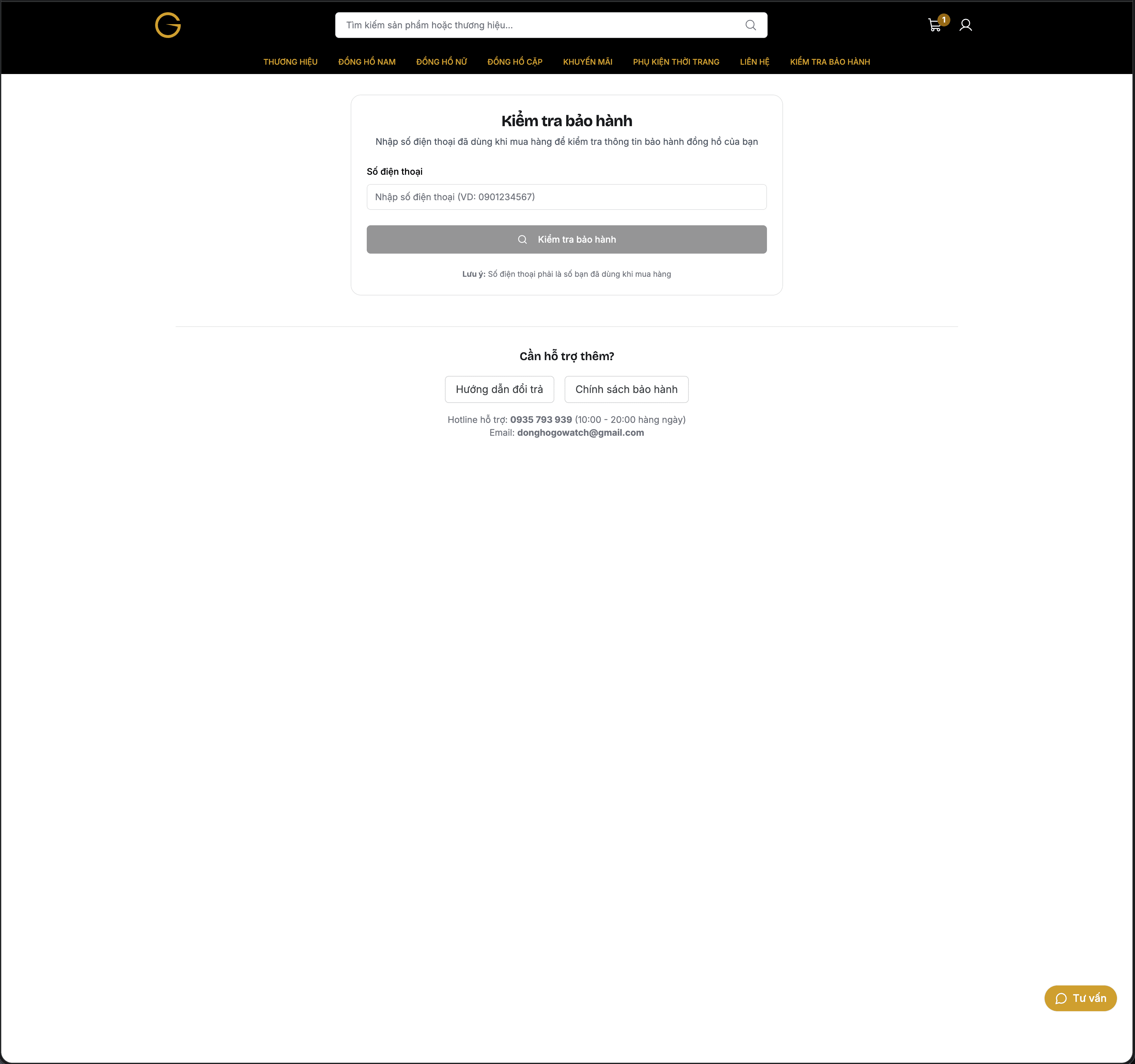Gowatch E-Commerce Platform
Overview
Full-Stack E-Commerce Rebuild | Full-Stack Developer (Solo)
Gowatch is a complete rebuild of an established watch and accessories e-commerce platform, transforming it from a legacy WordPress system into a modern, high-performance full-stack application. As the sole developer on this project, I took full ownership of the entire development lifecycle—from architecture design and technology selection to implementation, testing, and deployment.
The project involved migrating an active e-commerce business to a completely new tech stack while ensuring zero downtime and maintaining all existing functionality. I chose Next.js and NestJS as the core frameworks, leveraging their strengths in performance, SEO, and scalability. The new platform not only addressed immediate performance issues but was architected with future growth in mind, featuring a flexible database schema and modular backend architecture that allows for easy maintenance and feature additions.
The result is a lightning-fast, SEO-optimized platform that delivers a 70% improvement in load times and achieves 90+ Lighthouse scores across all metrics. This project showcases my ability to make strategic technical decisions, work independently on complex full-stack systems, and deliver production-ready applications that solve real business problems.




Key Features
- •Product catalog with advanced filtering and search
- •Full shopping cart and checkout flow
- •Admin dashboard for inventory and order management
- •SEO-optimized pages with Next.js SSR/SSG
- •Responsive design across all devices
Challenges
The client's existing WordPress-based e-commerce site had become a significant bottleneck for their business growth. Page load times averaged 6+ seconds, creating a poor user experience that likely resulted in abandoned carts and lost sales. The WordPress architecture, while initially convenient, had accumulated technical debt through plugins and customizations that made the site slow, difficult to maintain, and challenging to optimize.
Beyond performance issues, the site faced several critical limitations:
- Poor SEO Performance: Slow load times and suboptimal rendering hurt search engine rankings in a competitive market
- Scalability Concerns: The existing infrastructure couldn't efficiently handle growing product catalogs and traffic
- Maintenance Complexity: Managing WordPress plugins, theme updates, and custom code had become time-consuming and error-prone
- Limited Flexibility: Adding new features or modifying existing ones required working around WordPress constraints
The challenge was not just technical but also strategic: migrate an active e-commerce business to a new platform without disrupting operations, data loss, or customer experience. This required careful planning of the database architecture to handle complex product relationships, variants, and inventory management, while building a robust admin system that non-technical staff could use effectively.
Additionally, I needed to design a cost-effective infrastructure solution using modern cloud services that would provide high performance while keeping operational costs reasonable for a small to medium-sized business.
Solutions
Architecture & Technology Decisions
I architected a modern, decoupled full-stack solution leveraging industry-leading technologies chosen for their specific strengths:
- Next.js Frontend: Implemented server-side rendering (SSR) and static site generation (SSG) for optimal performance and SEO. Utilized Next.js's built-in image optimization and code splitting to minimize bundle sizes and improve initial page loads.
- NestJS Backend: Built a robust, scalable REST API using NestJS's modular architecture. This provides clear separation of concerns, making the codebase maintainable and testable while supporting future feature expansion.
- PostgreSQL Database: Designed a normalized relational database schema optimized for complex product relationships, inventory tracking, and order management. The schema supports flexible product variants, categories, and attributes without sacrificing query performance.
- Cloud Infrastructure: Selected cost-effective, scalable hosting solutions—Vercel for instant global CDN distribution of the frontend, Railway for reliable backend hosting with easy scaling, and Cloudinary for optimized image delivery with automatic format conversion and responsive sizing.
Performance Optimizations
- ⚡ 70% Faster Load Times: Reduced page load from 6 seconds to under 2 seconds through code splitting, lazy loading, and optimized asset delivery
- 🎯 90+ Lighthouse Scores: Achieved excellent scores across all metrics (Performance, Accessibility, Best Practices, SEO)
- 🖼️ Image Optimization: Implemented Cloudinary's automatic format selection (WebP, AVIF) and responsive images, reducing image payload by 60-70%
- 📱 Mobile-First Performance: Ensured fast loading even on slower mobile connections through optimized bundle sizes and progressive enhancement
SEO & Discoverability
- 🔍 Built-in SEO Support: Leveraged Next.js SSR/SSG for search engine-friendly HTML rendering, eliminating the indexing issues common with client-side rendered SPAs
- 📊 Analytics Integration: Implemented Google Analytics and Microsoft Clarity for comprehensive user behavior tracking and conversion funnel analysis
- 🎯 Structured Data: Added proper meta tags, Open Graph, and structured data markup for improved search visibility
Developer Experience & Maintainability
- 🏗️ Modular Architecture: Organized code into reusable components and services, reducing technical debt and making future updates straightforward
- 🔧 Type Safety: Used TypeScript throughout the stack to catch errors early and improve code reliability
- 📝 Clean Codebase: Established clear coding standards and project structure that simplifies onboarding and maintenance
- 🚀 CI/CD Pipeline: Configured automated deployments through Vercel and Railway for rapid, reliable updates
Business Impact
- 💰 Cost Efficiency: Reduced hosting and maintenance costs compared to WordPress hosting with multiple premium plugins
- 🛠️ Easier Management: Built an intuitive admin dashboard that allows non-technical staff to manage products, orders, and inventory without developer intervention
- 📈 Future-Ready: Created a scalable foundation that can easily accommodate new features like customer accounts, wishlists, reviews, or integration with third-party services
- ⚙️ Reduced Downtime: Eliminated issues from plugin conflicts and WordPress updates that previously caused site disruptions
Project Execution
- ✅ Zero-Downtime Migration: Carefully planned and executed the transition from WordPress to the new platform without affecting active customers
- 📅 3-Month Delivery: Completed the entire rebuild in 3 months of part-time work, demonstrating efficient project management and execution
- 🎨 Responsive Design: Created a modern, mobile-responsive interface using TailwindCSS that works seamlessly across all devices and screen sizes